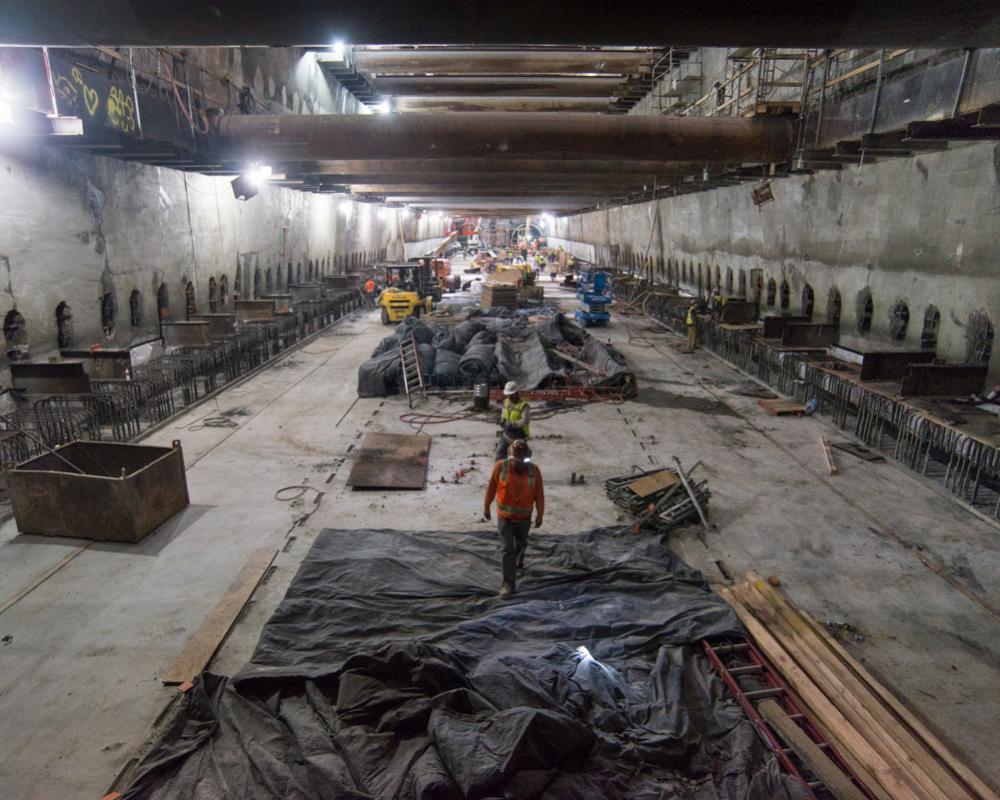Streetsblog will be publishing interviews on the best practices to Build Back Better throughout the summer on Streetsblog California, Streetsblog Los Angeles, and Streetsblog San Francisco. In our first piece, Damien Newton interviews Gwen Litvak, the senior vice president of the Bay Area Council. Back in 2019, the Faster Bay Area Coalition created a list of 15 things that should be done when designing and building transit mega-projects to increase the chances they’ll be built on time and on budget.
In this interview, Litvak shares some of the findings of that report.

SBSF: This is the opening piece in a series of how we can “Build Back Better” in ways that make sense both in California and nationally. Back in 2019, the Faster Bay Area Coalition did research on project delivery. Could we start with an overview of the report and some of the highlights that came out of it?
Gwen: The report was called “Super Charging Project Delivery” and it was a literature review and interviews about delivering mega-projects in the Bay Area. As you may know, the Bay Area has a history of delivering projects that are over budget and if we were going to raise a lot of revenue for different projects we realized we needed to reform the way we do project delivery.
$100 billion sounds like a lot of money, but in infrastructure terms it doesn’t go as far as you’d like. So to make the kinds of changes we need to make to get more people out of their vehicles and make commutes humane again, we realized that equation involved policy changes and infrastructure development.
Some of the ideas from this report made it into the FASTER proposal, and others are things we’re still working on now and we will continue to work on in the future.
SBSF: One of the things we discussed in the pre-interview is the need to have a “decider” and who that is made clear in the early stages of the project. While it’s important to have broad public outreach, confusion over who makes the decisions on what projects go forward can delay projects.
Gwen: The scenario played out with the Bay Bridge. The decision-making extended for more than 10 years because there was a lack of clarity and specificity of objectives and requirements.
Another up-front intervention that helps projects be successful is early stakeholder engagement. Really getting that feedback and understanding the challenges that the project might face up-front, will reduce the timeline for when the project is under construction. Changing things while the project is in construction is what makes projects take longer and cost more.
Clarity around the project and the objectives are things that are characteristics of successful projects.
Some of the pain points that we saw were a lack of clarity or specificity in objections or requirements: not exactly knowing what the project needs to do or what its objectives are, unclear goals and responsibilities, and an inability to hold people accountable.
That last point doesn’t mean that people aren’t doing their jobs, but that there is not a structure for shared accountability. This can be fixed by having penalties for errors in project management, but not for unforeseen technical issues. Penalties for things you can control, but not for things that you can’t.
Another issue to be considered is how to build up capacity to deliver megaprojects -- and this is not unique to the Bay Area. Every megaproject is different and takes so long that there isn’t a centralized workforce or authority that is responsible for delivering Link21 or DTX just to name a few. Those two projects will be delivered by different entities. At the federal level, the Bay Area Council, the Greater Washington Partnership, and the Regional Plan Association, are asking Congress to fund megaprojects at scale and remove barriers to delivering projects, but also for DOT to place a staff member on every megaproject so there’s a clear line between the local jurisdiction and the feds. And we’d like to see a construction entity that can address procurement processes, has staff dedicated to bringing parties together at the start of a project, tracking methods built in to ensure adherence to practices and policies, and has the legal ability to establish incentives for contractors. Delivering a megaproject is incredibly difficult and we need to support agencies doing so by developing regional expertise and having additional staff to deliver the project.
Another pain point is change requests and insufficient change management. This is part of the reason why having a clear decision-maker upfront is so important. Change requests make the project expensive, they delay the project, and they lead to miscommunication among the parties.
The next one is having procurement practices that are not tailored to the project’s intricacies. Using traditional delivery vehicles or using repeated processes are all things that don’t lead to a successful project and can create delay. Things we can do to prevent something like that is to evaluate potential project delivery processes, determine tradeoffs between a new procurement model and something older, pay a novel fee for teams to submit bids to increase competitiveness.
The next pain point is the unavailability of quality labor. It’s expensive to live here and it’s expensive to live in project areas. We need a bigger workforce here in the Bay Area if we want to build big projects. Sometimes there are stopgaps for individual projects, which extends timelines for other projects. There’s a time lag when we don’t have the workers to build large projects.
SBSF: Now we’re talking a lot about practices that can speed up the timelines for mega-projects. We’re a non-partisan organization, but I’m sure that folks in the White House and folks in Congress are going to want to see some of these projects under construction before the Congressional elections in 18 months and before the presidential elections two years after that.
But that being said, you were talking about up-front purpose statement being specific. But, one of the things we’ve talked a lot about over the years, especially when it comes to a highway project, is having a project statement that is too specific. For example, if your project statement is to “build a highway to connect these two points” then any discussion of transit or bicycle and pedestrian projects will be deemed outside the project area.
Gwen: This report was specifically about transit mega projects. We’re talking about the difference between what’s wanted for the project and what’s needed for the project. Timelines being accelerated because of political pressure or conflicting goals between stakeholders. These are things that can actually slow up a project.
I haven’t specifically done any highway work so I can’t speak specifically to this, but if you look at the Transbay Terminal or High-Speed Rail or the Bay Bridge: not having a clear way to arbitrate between what is wanted versus what is needed for that project is part of the delay.
SBSF: So what you’re more referring to is people that see a big project and want it to be “all things to all people” and keep wanting to add things to it as it moves forward and not a statement that predetermines the outcome of stakeholder engagement and environmental review.
Gwen: If you don’t set out a clear requirement at the start of the project, it’s just that...not clear where you’re going. One thing we haven’t done in the Bay Area are these business case analysis.
Caltrain did a great job with its business plan and showed what investments were needed for Caltrain’s future and how Caltrain would get there. It’s a worthwhile exercise for all of us to do- really.
I’m not saying that “what’s wanted” shouldn’t make it into the project or won’t make it into the project. But at the end of the day if you want to get a project in on time, or under-budget or even close-to-on-time, you need to identify those factors pretty clearly.
We’re talking a lot about what needs to happen locally with different agencies to keep things on time and on budget...but there’s a lot of federal money out there these days. If you could tell the federal agencies that are in charge of doling this money out that there is one thing they should change or require to keep these projects moving what would it be?
We actually just sent a letter to The Hill requesting a number of different changes. But let me talk a second about the past before I talk about the present.
In the past I worked in the Senate on the Hurricane Sandy Recovery Bill. Because of what happened with Hurricane Katrina, the Hurricane Sandy Bill had an incentive that if a city or county completed a project under the budget and faster than the FEMA estimate, then the city or county could keep the extra funds.
So what you saw was people prioritizing on; not that agencies weren’t doing so before but there was a shared reason to bring everyone into a room and clearly plan out next steps. There was a financial incentive to put the time and put the resources into figuring out the issues up-front and not kicking them down the road.
In our letter, we asked to Streamline project approval for mega multimodal projects and ensure accountability and efficiency in the project delivery process by designating a single federal agency to drive projects toward completion and minimize delay in the federal approval process (e.g., Chicago’s CREATE program). We also asked to streamline the FTA Capital Investment Grants program, which has some of the highest bureaucratic hurdles at USDOT that create inefficiencies and increase project costs (e.g., changes included in the House T&I Committee’s INVEST in America Act from the 116th Congress).
Those are two things I would change at the federal level.
At the state or regional level, the ability to do Programmatic EIRs: Prioritize Programmatic EIRs so that specific sub-projects can tier off rather than conduct their own full environmental review anew. This would be most beneficial for small, repetitive, non-controversial components of a project, though one could make an argument for a programmatic EIR for designated statewide significant corridors or hubs in the California Statewide Rail Plan. Programmatic EIRS could cut 1-2 years off the review process. CEQA provides a significant value to our planning process because it allows for stakeholder engagement. We need to still have the stakeholder engagement -- but expedite small, repetitive, non-controversial components where we can.
SBSF: Going back to the federal asks, you’ve talked about the need for a clear local decider, what about having a clear leader for a project at the federal level?
Gwen: Another thing the letter also asks for is one federal agency to drive a project towards completion and streamline the federal process. In Chicago, they were using what they called the Create Program, a USDOT person came to Chicago and was in charge of making sure the federal side worked.
If you’re in San Francisco, it’s pretty hard to keep all the federal players abreast of what’s going on, even with the Internet and Zoom, so having a single point person in a federal agency is something that would make a huge difference.
Another thing we ask about funding mega-projects is that there has to be a consistent source of funding. Right now we don’t actually have a dedicated source of funding for trains. We have the Federal Surface Transportation Bill, which is supposed to be reauthorized every five years, but often times isn’t. Oftentimes there’s just a continuing resolution, so it’s often not clear that there’s going to be a funding source available in the future.
Creating a large program, that blends inner-city and passenger rail programs, that connects city centers, that reduces congestion...that’s what we need. These programs don’t fit into an existing federal program.





